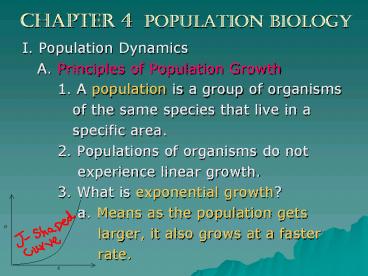Chapter 4 Population Biology - PowerPoint PPT Presentation
1 / 6
Title:
Chapter 4 Population Biology
Description:
Chapter 4 Population Biology I. Population Dynamics A. Principles of Population Growth 1. A population is a group of organisms of the same species that live in a – PowerPoint PPT presentation
Number of Views:229
Avg rating:3.0/5.0
Title: Chapter 4 Population Biology
1
Chapter 4 Population Biology
- I. Population Dynamics
- A. Principles of Population Growth
- 1. A population is a group of organisms
- of the same species that live in a
- specific area.
- 2. Populations of organisms do not
- experience linear growth.
- 3. What is exponential growth?
- a. Means as the population gets
- larger, it also grows at a faster
- rate.
2
- 4. What can limit growth?
- a. Limiting factors such as
availability of food, disease, - predators, or lack of space will
cause a population - growth to slow.
- 5. The number of organisms of one species
that an - environment can support indefinitely
is its carrying - capacity.
- 6. When a population overshoots the
carrying capacity, then - limiting factors may come into
effect. - 7. Deaths begin to exceed births and the
population falls - below carrying capacity.
- B. Reproduction Patterns
- 1. Life-history pattern is an organisms
reproductive pattern. - 2. Rapid life-history pattern organisms
have a small - body size , mature rapidly, reproduce
early, and have - a short life span.
- 3. Slow life-history pattern organisms
reproduce and mature - slowly, and are long-lived. They
maintain population sizes - art or near carrying capacity.
3
- 4. Two limiting factors that are related
to dispersal - a. density-dependent factors Factors
that are related to the - density of a population Include
disease, competition, - predators, parasites, and food
- b. density-independent factors affect
populations no matter how - large or small Include volcanic
eruptions, temperature, - storms, floods, drought, chemical
pesticides, and major - habitat disruption
- C. Organism Interactions Limit Population Size
- 1. Populations also are limited by contact
with other organisms in a - community.
- 2. When population numbers are low,
resources build up and - become plentiful. Then the population
will increase in size and - competition for resources increases
- 3. When populations become crowded,
- individuals may exhibit symptoms of
stress - a. aggression
4
- II. Human Population
- A. World Population
- 1. Demography is the study of human
- population size, density, and
distribution, - movement, and its birth and death
rates.
5
- 2. There are a number of factors that
- determine population growth rate.
- a. births (birthrate) number live
births per - 1000 population in a given year
- b. deaths (death rate) number of
deaths - per 1000 population in a given
year - c. immigration movement of
individuals - into a population
- d. emigration movement of individuals
out - a population
- 3. Unless the growth rate becomes
negative, - the population continues to grow,
but just - not as rapid as it did before.
- 4. Doubling time is the time needed for
a - population to double in size.
6
- 5. Age Structure refers to the number of
people at - each different age level.
- 6. The needs for populations differ greatly
- throughout the world.
- 7. There are uneven population growth
patterns - throughout the world.

